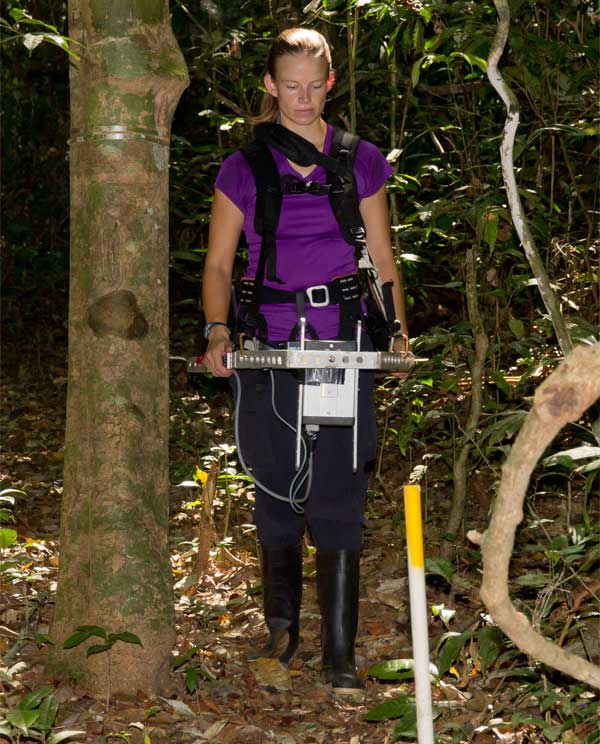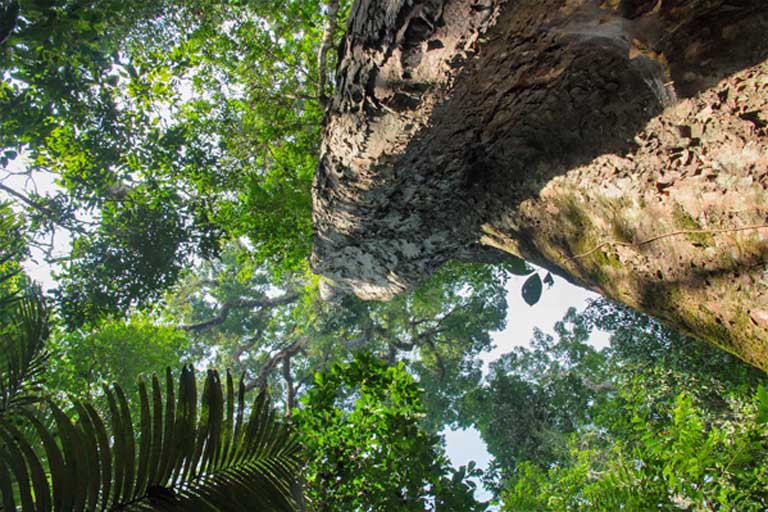- Large-scale satellite data has shown that while large trees expand their crown during the dry season, small trees drop leaves – possibly due to limited light availability in the shaded understory. A new study finds that tree response to dry weather is far more complex, influenced by exposure to the sun and root depth.
- Detailed measurements of leaf growth and leaf loss during the annual dry season and extreme drought events shows that small trees respond differently to water deprivation depending on their surrounding environment – shaded trees gain leaves but exposed trees tend to lose them, a possible sign of dehydration stress.
- Two novel study approaches revealed a complex pattern of leaf growth and loss in response to dry weather: ground-based lidar imaging that produced high-resolution 2D image slices of forest structure, and statistical division of data based on an understory tree’s distance from the canopy top, rather than from the ground up.
- Losing leaves could spell death for individual trees, but these small-scale changes can also impact transpiration and have consequences for regional weather patterns and regional climate change. Also, importantly, degraded forests, with many open clearings, could be less resilient to worsening Amazon drought.

Small trees in the Amazon rainforest understory are more vulnerable to drought than their larger counterparts, but their fate depends on their local environment, according to a study published in New Phytologist.
Marielle Smith from Michigan State University and an international team of researchers used hand-held lidar to complete monthly surveys of the surface area of leaves at different heights in Tapajós National Forest in Pará state in the Brazil Amazon between 2010 and 2017 to obtain their results. The portable lidar instrument uses a laser to map the leaves in the forest canopy in two-dimensional slices up through the forest structure.
Across the whole forest, they found that trees in the upper canopy tended to gain leaves during the dry season and lose them again in the wet season, whereas trees in the lower canopy showed the opposite behavior. This opposing trend between the upper and lower canopies matches the results of a previous satellite-based study of seasonal changes in leaf area, and is thought to be due to limited light availability in the lower canopy.
However, a closer look at the patterns of leaf growth and loss in different micro-environments within the forest ecosystem revealed a more complex pattern.
“What was exciting for us was that because we’re using a ground-based lidar system, the resolution of our data is very high and so we were able to break the lower canopy into two parts,” said Smith: small trees in the lower canopy shaded by larger trees, and small trees in forest clearings exposed directly to the sun. The researchers found that it was actually the small trees exposed to high sunlight levels in forest openings that lost leaves during dry periods, while shaded trees added to their leaf area in synchrony with the larger canopy trees above them.


Although the lack of groundwater available during the dry season can stress trees, it is also the sunniest time of the year when photosynthesis rates are high allowing for rapid leaf growth. These antagonistic forces mean that dry spells impact different layers of the forest in different ways, the researchers suggest. Large, old trees tend to have more extensive root systems making them better able to cope with limited water supplies, and so are able to expand their crowns to make use of the available sunshine. Protected by the shade of the canopy above them, small trees in the cooler, humid understory can also expand their leaf area. Small trees in high sun environments, on the other hand, experience the full strength of the sun, but lack extensive root systems to help them cope with the rapid water loss this can cause, leading them to drop their leaves.
This difference became evident when the scientists looked at the forest from a new perspective. Studies traditionally divide forest into vertical layers based on their height from the ground up, but Smith and her colleagues divided that distance from the top of the canopy down, and therefore by the distance from the source of light, a measurement more relevant to the trees themselves. Dividing the forest in this way showed that for small trees, light level exposure in their particular patch of forest made a crucial difference to their experience of the dry season and drought.
“It’s really critical to understand whether the tree is in a shaded environment or a really high sun environment as that’s going to determine – according to our results – how the tree is going to respond [to drought],” said Smith.

Mauro Brum, a plant ecologist at the University of Campinas in São Paulo, Brazil complimented the study, saying its novelty is that it considers both the light- and water-limitations affecting plants in different microenvironments.
Small trees in exposed areas do not have deep root systems to buffer them against dry spells and may drop their leaves. However, a loss of leaf area could represent a deliberate strategy on the part of drought-stressed trees to reduce water loss, or a symptom of trees suffering due to dehydration. Smith says that further studies that link leaf area to tree physiology and mortality are needed to confirm the longer-term effects of drought and leaf loss on trees in different microenvironments.
The trends observed during the annual dry season were magnified during drought years, such as the 2015-2016 El Niño event that brought drought to much of the Amazon rainforest, suggesting that trees in forest clearings – which could be created naturally when an old canopy tree dies, or artificially by human activities like selective logging – may be particularly vulnerable to escalating droughts predicted with climate change. The Tapajós basin possesses a wet forest with strong dry seasons, leading scientists to believe it is a good proxy for the response of rainforests to climate change. As one of the driest evergreen forests in the Amazon, the Tapajós forest “might be a kind of canary in the coalmine in terms of how other forests in the Amazon may respond to increasingly dry periods that they’re expected to experience in the future,” says Smith.
One implication of Smith’s study is that larger trees may be more resilient to drought than previously thought. There is conflicting evidence on how tall rainforest trees cope with drought; some studies have reported that tall trees are particularly susceptible to stress during dry periods because their long vascular structures are vulnerable to the formation of damaging bubbles, while others have shown that tall trees are in fact the most resilient to drought.
Last year, Brum published his own data from the Tapajós National Forest, which showed that tall trees have extremely deep root systems and didn’t experience a high level of drought-stress during the peak of the 2015-16 El Niño drought. “Deep water access by roots is important to sustain canopy forest function during [the] dry season while the light availability is high,” he said.

Brum’s results could explain why large trees are able to expand their leaf area to take advantage of high light availability in the dry season, while small trees exposed in forest clearings can’t. “I was very happy to see how closely [Smith et al’s] finds match to the [study] I published last year,” said Brum.
Leaf area is an important characteristic of a forest because it determines how much water and gases are exchanged with the atmosphere, which in turn can influence local weather and larger scale climate dynamics. For a forest like the Amazon, which generates up to 50 percent of its own rainfall and can influence weather patterns thousands of kilometers away, the small-scale changes in leaf area in response to drought can have a huge knock-on effect.
“Ecosystem scientists now are having to deal with these two massively different scales – from the leaf to the Amazon-basin,” says Smith, who thinks new technologies can help bridge the gap. For example, Global Ecosystem Dynamics Investigation (GEDI) – a high-resolution laser that can make precise measurements of forest canopy height and structure and the topology of the ground underneath – was launched for deployment on the International Space Station (ISS) in December 2018 and is scheduled to begin imaging the world’s forests later this year. Combining large-scale GEDI data with fine-scale information such as infrared data collected by drone, could help scientists unravel the interconnected relationship between forest microenvironments and basin-wide dynamics.
Citation:
Smith, M. N., Stark, S. C., Taylor, T. C., Ferreira, M. L., de Oliveira, E., Restrepo‐Coupe, N., Chen, S. , Woodcock, T., dos Santos, D. B., Alves, L. F., Figueira, M. , de Camargo, P. B., de Oliveira, R. C., Aragão, L. E., Falk, D. A., McMahon, S. M., Huxman, T. E. and Saleska, S. R. (2019) Seasonal and drought related changes in leaf area profiles depend on height and light environment in an Amazon forest. New Phytologist. doi: 10.1111/nph.15726
BANNER IMAGE: The upper canopy of Tapajós National Forest. Image by Marielle Smith.
FEEDBACK: Use this form to send a message to the author of this post. If you want to post a public comment, you can do that at the bottom of the page.
